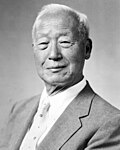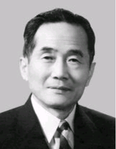From Wikipedia, the free encyclopedia
1956 South Korean presidential election
Presidential election
Vice presidential election
Presidential and vice presidential elections were held in South Korea on 15 May 1956.[ 1] Syngman Rhee , who won 70.0% of the vote. Voter turnout was 94.4%.[ 2]
Election posters for Rhee's Liberal party Rhee, who at that time held a virtual monopoly on political power, was opposed by Shin Ik-hee and Cho Bong-am . Shin died before the election by disease, and Cho campaigned on a platform of peaceful reunification in opposition to Rhee's policy of "March North and unify Korea".[ 3] National Security Law and executed.[ 4]
Candidate Party Votes % Syngman Rhee Liberal Party 5,046,437 69.99 Cho Bong-am Independent 2,163,808 30.01 Total 7,210,245 100.00 Valid votes 7,210,245 79.52 Invalid/blank votes 1,856,818 20.48 Total votes 9,067,063 100.00 Registered voters/turnout 9,606,870 94.38 Source: Nohlen et al .
Region
Syngman Rhee
Cho Bong-am
Votes
%
Votes
%
Seoul
205,253
63.3
25,631
36.7
Gyeonggi
607,757
77.1
44,967
22.9
Gangwon
644,693
90.8
10,516
9.2
North Chungcheong
353,201
86.1
25,875
13.9
South Chungcheong
530,531
77.1
56,590
22.9
North Jeolla
424,674
60.2
109,490
39.8
South Jeolla
741,623
72.1
99,885
27.9
North Gyeongsang
621,530
55.3
129,791
44.7
South Gyeongsang
830,492
62.3
288,654
37.7
Jeju
86,683
87.9
6,105
12.1
Total
5,046,437
70.0
797,504
30.0
Source: National Election Commission[ 5]
Candidate Party Votes % Chang Myon Democratic Party 4,012,654 46.43 Lee Ki-poong Liberal Party 3,805,502 44.03 Lee Beom-seok Independent 317,579 3.67 Yun Chi-young Korea Nationalist Party 241,278 2.79 Paeg Song-uk Independent 230,555 2.67 Yi Yun-yong Choseon Democratic Party 34,926 0.40 Total 8,642,494 100.00 Valid votes 8,642,494 95.35 Invalid/blank votes 421,700 4.65 Total votes 9,064,194 100.00 Registered voters/turnout 9,606,870 94.35
Region
Chang Myon
Lee Ki-poong
Lee Beom-seok
Yun Chi-young
Paeg Song-uk
Yi Yun-yong
Votes
%
Votes
%
Votes
%
Votes
%
Votes
%
Votes
%
Seoul
451,037
76.9
95,454
16.3
21,530
3.7
12,445
2.1
3,802
0.6
2,285
0.4
Gyeonggi
450,140
44.9
424,104
42.3
55,621
5.5
40,720
4.1
25,216
2.5
6,768
0.7
Gangwon
103,493
13.6
611,704
80.2
23,612
3.1
14,046
1.8
7,052
0.9
3,225
0.4
North Chungcheong
159,310
33.7
245,218
51.8
28,264
6.0
14,411
3.0
24,727
5.2
1,347
0.3
South Chungcheong
374,209
43.7
364,750
42.6
51,589
6.0
29,054
3.4
31,895
3.7
4,675
0.5
North Jeolla
428,410
51.0
338,283
40.3
28,954
3.4
25,430
3.0
15,596
1.9
2,738
0.3
South Jeolla
529,341
43.7
549,279
45.3
33,890
2.8
25,979
2.1
70,628
5.8
3,294
0.3
North Gyeongsang
715,342
54.4
475,754
36.1
41,037
3.1
38,188
2.9
40,544
3.1
5,303
0.4
South Gyeongsang
778,903
52.5
623,409
42.0
30,264
2.0
38,288
2.6
7,899
0.5
4,575
0.3
Jeju
22,469
19.9
77,547
68.6
7,818
6.9
2,717
2.4
2,196
1.9
216
0.2
Total
4,012,654
46.4
3,805,502
44.0
317,579
3.7
241,278
2.8
230,555
2.7
34,926
0.4
^ Dieter Nohlen , Florian Grotz & Christof Hartmann (2001) Elections in Asia: A data handbook, Volume II , p420 ISBN 0-19-924959-8 ^ Nohlen et al., p464
^ Kim, H-A (2004). Korea's development under Park Chung Hee . RoutledgeCurzon, pp. 42–43.
^ Kim, p. 42.
^ "개표현황" . National Election Commission . Archived from the original on 2017-07-10. Retrieved 14 April 2021 .





